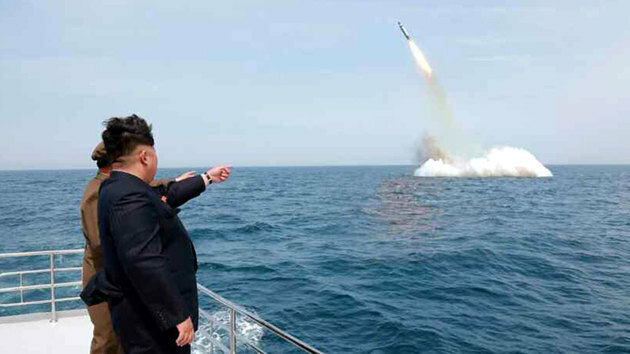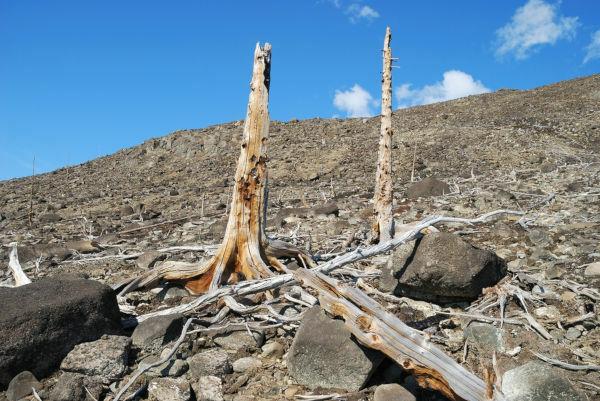O conflict between North Korea and the United States warmed up again with recent missile launches.
In 2018, the North Korean government suspended its ballistic tests and both presidents met in June 2018 and February 2019.
However, in May 2019, leader Kim Jong-un returned to launching short-range missiles from his military bases.
As early as December 2019, the North Korean leader announced that he no longer feels obligated to comply with the suspension of long-range missile tests, as he feels there are no concrete proposals from Washington.
To understand the origin of this conflict we need to go back to the Korean War (1950-1953) where the two nations became enemies due to ideological differences.
Tension between the United States and North Korea
In 2017, the United States and North Korea revived their political and military differences with warnings of attacks from both sides.
The North Korean government, led by Kim Jong-un, has verbally threatened the United States and made known weapons tests as it hasn't done for a long time.
For its part, the American government is concerned about its two regional allies: South Korea and Japan. Today, with Donald Trump's rise to power in the United States, responses to these military warnings are increasingly direct.

One of the first visits President Trump received upon his election was from Japanese Prime Minister Shinzō Abe. The Japanese politician wanted to strengthen the defense alliances that exist between the two countries.
Likewise, the meeting between the representatives was intended to signal to North Korea that the Japan he is not alone if attacked.
In August 2017, Kim Jong-un It threatened to bomb the island of Guam, a territory organized but not incorporated into the United States, located in Micronesia. The island has an American military base with six thousand soldiers and B-52 bomber planes.
In a tense week, when US President Donald Trump threatened to retaliate against President Kim Jong-un, the North Korean leader finally backed down and halted the attack.
The hostility between the two nations will be the great challenge of the Trump government.
However, how did the rivalry between the two countries start?
Historical Context of the US-North Korea Conflict
In 1910, Japan, in full imperialist expansion, invades the Korean peninsula and guarantees the supply of workers and raw materials for the Japanese Empire. Japanese colonization was brutal and full of episodes of violence.
In 1945, after Japan was defeated in World War II, Korea became one of the stages of the Cold War. Divided from Parallel 38 when the USSR took the territory to the north, while the south was occupied by the United States.
Korean War (1950-1953)

In 1947, the USSR refuses to recognize the free elections promoted by the UN. Thus, in 1948 a new country is created: the Democratic People's Republic of North Korea whose capital is Pyongyang.
Two years later, North Korea claims that its border had been crossed by South Koreans and uses this pretext to invade South Korea.
The country is almost all taken over, but a UN intervention, led by the USA, helps its Asian ally, and manages to expel the invader.
Thus began the Korean War, which would last for three years from 1950-1953. North Korea is aided by China and the counteroffensive begins.
The conflict left three million people dead and countless material losses. The borders between the two countries return to the 38th Parallel, through an armistice.
Technically, the two nations are still at war, as there has been no peace treaty. Both are separated by a 4 km wide demilitarized zone.
Communist Dynasty in North Korea
At the end of the war, a totalitarian government was installed whose pillars are the Workers' Party and the Army. In this way, the first and only communist dynasty in the world was inaugurated: the Kims.
Supported by the USSR and, mainly, by China of Mao Tse-Tung, North Korea would close itself off to the world. There are an estimated 80,000 to 100,000 political prisoners in a population of 22 million whose existence is denied by the North Korean government.
The current leader, Kim Jong-un, is accused of killing his own uncle, half brother and the Defense Minister, who were considered traitors.
In addition to this internal terrorist policy, it joins an aggressive foreign policy where threats of attacks are constant.
Several maritime incidents are registered between the two Koreas and weapons tests were carried out throughout the first decade of the 21st century.
Nuclear Tests in North Korea

In 2003, North Korea withdrew from the Atomic Weapons Non-Proliferation Treaty. In 2006, it carried out its first underground nuclear test.
Neighboring countries - China, Russia, Japan, South Korea - as well as the United States, are closely following each of the military tests carried out by the North Korean army.
In 2009, a long-range missile was unsuccessfully tested with the aim of reaching American territory. Also this year, another nuclear missile was tested.
With Kim Jong-un's coming to power, military testing continued. In 2012 there were more weapons simulations and in 2017 a long-range missile was successfully launched.
THE China is concerned about this escalation of weapons and threats by North Korea, as before, only the Chinese set the tone in the region.
Since its economic opening, China has also approached South Korea for commercial interests. In this way, it tries to balance alliances with two, until now, irreconcilable countries.
End of Nuclear Program in North Korea

The Winter Olympics held in South Korea, in February 2018, became a scenario for the two Koreas to come together.
Kim Jong-un's sister, Kim Yo Jong, accompanied the North Korean delegation and invited South Korean President Moon Jae-in to visit the country.
Surrounded by intense expectations, the meeting took place in the demilitarized zone, on April 27, 2018. It was a symbolic meeting, as it was the first time a South Korean president had set foot in North Korea.
At the meeting, the end of the nuclear weapons program and the closing of North Korean military bases were announced. This measure was received with caution and joy throughout the region.
In addition, Kim Jong-un will allow the families to reconnect with their southern relatives and the North Korean time will once again be the same as South Korea.
Likewise, both countries agreed to start talks to sign peace between the two parties.
Rail link between South Korea and North Korea
On June 26, 2018, the ministers responsible for Transport in South Korea and North Korea met to discuss a possible rail link between the two countries.
The objective is to modernize the North Korean railways and thus enable an overland export route to South Korea with China and Russia.
However, any work will only be carried out if the economic sanctions imposed by the UN on North Korea are lifted.
Donald Trump and Kim Jong-un encounters

US President Donald Trump and North Korean leader Kim Jong-un met on June 12, 2018 in Singapore. It is a historic meeting, as for the first time the leaders of these countries spoke face to face.
However, the meeting was the first step on a long path that will follow through diplomatic negotiations. Although they signed a commitment to peace and denuclearization, the two nations did not commit to deadlines of any kind.
Likewise, the return of the remains of American soldiers killed in the Korean War is planned, as well as the end of military exercises between South Korea and the United States.
Donald Trump and Kim Jong-un meeting in Vietnam
The leaders met again in February 2019, in the city of Hanoi, Vietnam.
Trump reiterated that he would only lift economic sanctions if Kim Jong-un destroyed and renounced nuclear weapons. As the North Korean representative did not relent, the meeting ended ahead of schedule and without any progress.
Before returning to his country, Kim Jong-un paid a visit to China and later would restart with missile launch tests. In July 2019, two short-range missiles were launched by North Korea.
Continue research on this subject:
- North American Imperialism
- Bush doctrine
- U.S
- Enem geography: subjects that fall the most



